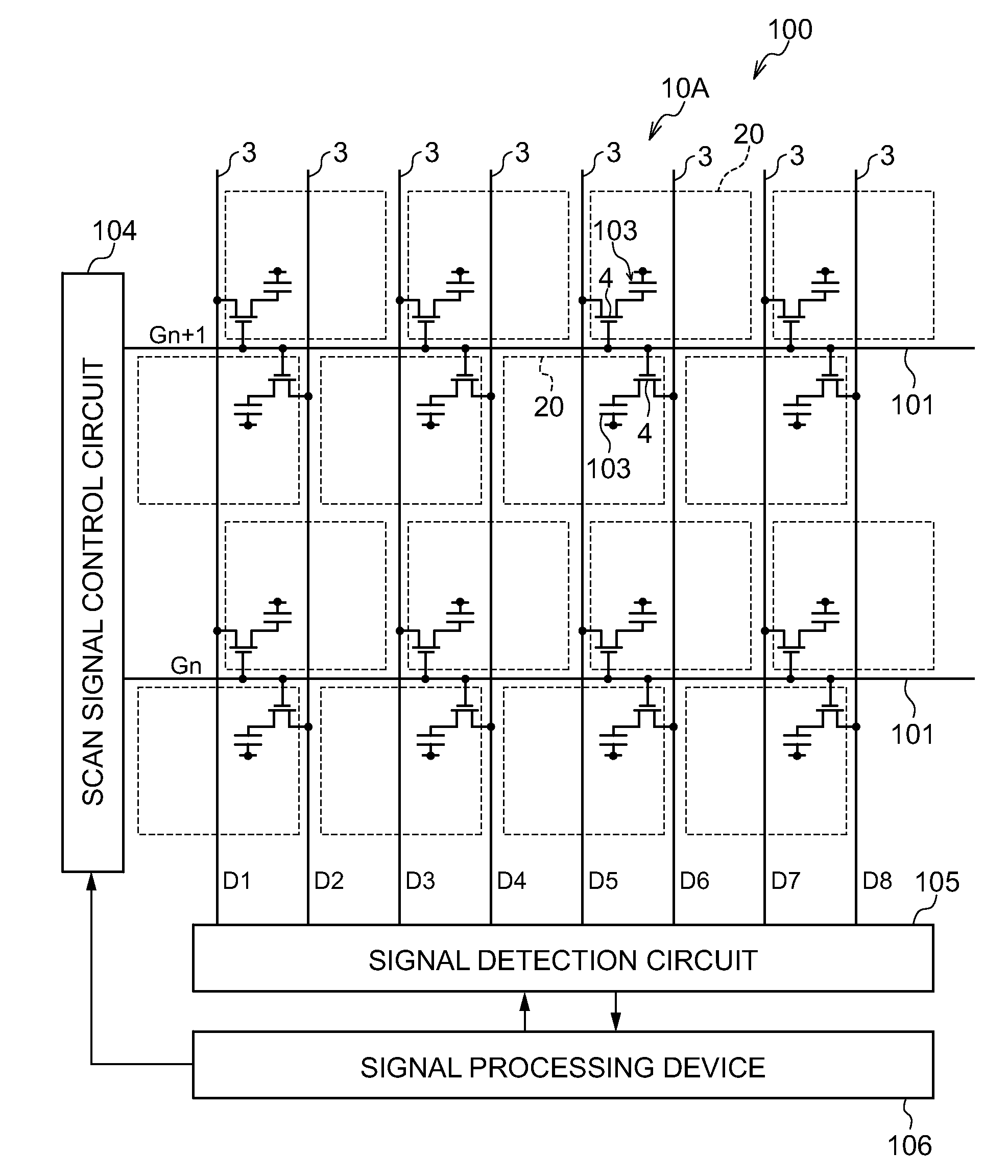Radiation detector
a detector and radiation technology, applied in the field of radiation detectors, can solve the problems of large number of frames of radiation image read-out per second (the frame rate), difficult to image video images of high frame rate, and speed of pixel read-out, so as to suppress differences in line capacitance and increase the speed of reading out pixels
- Summary
- Abstract
- Description
- Claims
- Application Information
AI Technical Summary
Benefits of technology
Problems solved by technology
Method used
Image
Examples
first exemplary embodiment
[0058]As a first exemplary embodiment, a case in which the present invention is applied to an indirect-conversion-type of radiation detector 10A, which temporarily converts radiation to light and converts the converted light to charges, is described.
[0059]FIG. 1 illustrates the overall structure of a radiographic imaging device 100 that includes the radiation detector 10A according to the first exemplary embodiment.
[0060]As illustrated in FIG. 1, the radiographic imaging device 100 according to the present exemplary embodiment includes an indirect-conversion-type radiation detector 10A. Note that, a scintillator that converts radiation to light is not illustrated in FIG. 1.
[0061]The radiation detector 10A includes plural pixels 20 that are configured to include sensor portions 103 and TFT switches 4. The sensor portions 103 generate charges by illumination of light, and accumulate the generated charges. The TFT switches 4 read out the charges accumulated in the sensor portion 103.
[0...
second exemplary embodiment
[0094]Next, as a second exemplary embodiment, a case in which the present invention is applied to a direct-conversion-type of radiation detector, which converts radiation directly to charges, is described.
[0095]FIG. 4 illustrates the overall structure of the radiographic imaging device 100 that includes a radiation detector 10B according to the second exemplary embodiment. Herein, portions that correspond with the first exemplary embodiment described above (FIG. 1) are described with the same reference numerals as in the first exemplary embodiment.
[0096]In the radiation detector 10B, the plural pixels 20 are configured to include the sensor portions 103, the charge storage capacitors 5 and the TFT switches 4. The sensor portions 103 generate charges according to irradiation of radiation. The charge storage capacitors 5 accumulate the charges generated by the sensor portions 103. The TFT switches 4 read out the charges accumulated in the charge storage capacitors 5.
[0097]Similarly to...
third exemplary embodiment
[0121]Next, as a third exemplary embodiment, a case is described in which, in each pixel 20 of the direct conversion type radiation detector 10B, the TFT switch 4 and the charge storage capacitor 5 are separately disposed in two regions which are divided by the signal line 3 passing through a middle portion of the pixel 20.
[0122]FIG. 7 shows a plan view illustrating structure of the radiation detector 10B according to the present exemplary embodiment. Herein, portions that are the same as in the second exemplary embodiment (see FIG. 5) are assigned with same reference numerals and description thereof will be omitted.
[0123]As illustrated in FIG. 7, in the radiation detector 10B, the TFT switch 4 and charge storage capacitor 5 at each pixel 20 are disposed separately in two regions which are divided by the signal line 3 passing through the middle portion of the pixel 20.
[0124]FIG. 8 shows a cross-sectional diagram taken along A-A of FIG. 7. Portions that are the same as in the second ...
PUM
 Login to View More
Login to View More Abstract
Description
Claims
Application Information
 Login to View More
Login to View More - R&D
- Intellectual Property
- Life Sciences
- Materials
- Tech Scout
- Unparalleled Data Quality
- Higher Quality Content
- 60% Fewer Hallucinations
Browse by: Latest US Patents, China's latest patents, Technical Efficacy Thesaurus, Application Domain, Technology Topic, Popular Technical Reports.
© 2025 PatSnap. All rights reserved.Legal|Privacy policy|Modern Slavery Act Transparency Statement|Sitemap|About US| Contact US: help@patsnap.com



